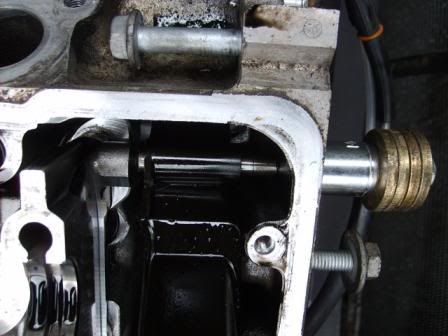 |
 |
 |
 |

|


|
|
|
|
|
|
#1
|
||||
|
||||
|
Alternative tool to remove the slider pin???
on a 617 or 616, is there another tool able to remove the pin that holds the timing chain slider?
The FSM calls for an impact puller but the benz tool is very expensive. I am stuck at that point in the removal of the cylinder head head.
__________________
------------------------------------------ Aquilae non capunt muscas! (Eagles don't hunt flies!) 1979 300SD Black/Black MBtex239000mi 1983 300TD euro-NA. White/Olive Cloth-MBtex 201000mi. Fleet car of the USA embassy in Morocco 1983 240D Labrador Blue/Blue MBtex 161000mi |
|
#2
|
|||
|
|||
|
Get a 6mm socket head cap screw that's about 2" in length. Get a nut to thread onto the screw. Get a stack of washers that has the ID of the washer larger than the OD of the pin. Stack the washers on the screw beneath the nut.
Thread the screw into the pin (with nut and washers beneath the head). Hold the head of the screw with an allen wrench and tighten the nut down onto the washers. Keep tightening and the nut will pull the pin out of the head and into the ID of the washers. You might find a socket that can also take the place of the washers. |
|
#3
|
||||
|
||||
|
I have seen a Pic similiar to what Brian said but intesd of a stack of wahers or a socket 2 or 3 nuts with IDs slightly greater than the pin were used as the spacers.
__________________
84 300D, 82 Volvo 244Gl Diesel |
|
#4
|
|||
|
|||
|
Quote:
ditto. a socket works great and provides minimum 'slop'. Put a very thick washer b/w the head of the bolt and the socket. Use a hardened bolt, the soft crappy stuff at hardware stores (mass quantities intended for construction) will strip 60% of the time. Look for bolts with markings on them. Turn slowly and pay attention to the 'feel' of each turn of the bolt. |
|
#5
|
|||
|
|||
|
Quote:
that will work in some spots, but in others (such as around the vacuum pump) you will not have enough clearance b/w your 'spacer' and a nearby appendage on the block. |
|
#6
|
||||
|
||||
|
Actually that what the recommended tool look like in the FSM. Thank so much guys for the advices.
__________________
------------------------------------------ Aquilae non capunt muscas! (Eagles don't hunt flies!) 1979 300SD Black/Black MBtex239000mi 1983 300TD euro-NA. White/Olive Cloth-MBtex 201000mi. Fleet car of the USA embassy in Morocco 1983 240D Labrador Blue/Blue MBtex 161000mi |
|
#7
|
|||
|
|||
|
Use a socket head cap screw.
Don't make me tell you again. 
|
|
#8
|
|||
|
|||
 I have to admit, I didn't actually visualize your suggestion. ^^ in case I'm not alone. Why do you suggest this? |
|
#9
|
|||
|
|||
|
Quote:
The primary reason to use them is their durability. They are always very hard, by definition. They need to take the extreme localized forces from an allen key and such a screw would quickly deform if not of sufficient hardness. They do make stainless steel socket head cap screws, which are nearly worthless for getting to the specified torque of the fastener. However, outside of the stainless, you'll never go wrong with a socket head cap screw. On the other hand, select a typical "bolt" or "hex head cap screw" and you are not assured of any grade or hardness. They can run the gamut from just past low carbon steel to steel that is better than a socket head cap screw. The latter is very difficult to find. |
|
#10
|
||||
|
||||
|
Now a slight complication arises when you try to do it with a head equipped with a SLS. The nuts have to be of a very exact size to fit in the channel going to the pin.
__________________
------------------------------------------ Aquilae non capunt muscas! (Eagles don't hunt flies!) 1979 300SD Black/Black MBtex239000mi 1983 300TD euro-NA. White/Olive Cloth-MBtex 201000mi. Fleet car of the USA embassy in Morocco 1983 240D Labrador Blue/Blue MBtex 161000mi |
|
#11
|
|||
|
|||
|
Quote:
__________________
1987 W201 190D |
|
#12
|
||||
|
||||
|
I used this method many times successfully, not a great pic but you get the idea -

__________________
David 1996 Mercedes S124 E300TD - 129k - rolling restoration project - 1998 Mercedes W210 300TD - 118k (assimilated into above vehicle) |
|
#13
|
|||
|
|||
|
I've only used grade 12.9 for the past 20 years because all screws come from McMaster. For this specific application, greater strength is absolutely desired due to the possibility of the pin being difficult to remove.
|
|
#14
|
|||
|
|||
|
I used the recommended bolt and washer stack method recently and it worked very well. It might be a good idea to chase the internal thread of the pin with a tap to be sure you're engaging enough threads.
|
|
#15
|
|||
|
|||
|
.........you'd need a "bottoming tap" for that endeavor if you want that result.
|
 |
| Bookmarks |
| Thread Tools | |
| Display Modes | |
|
|